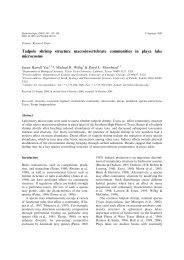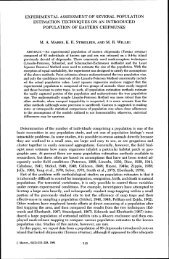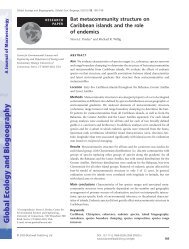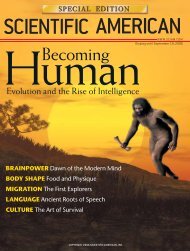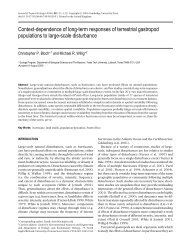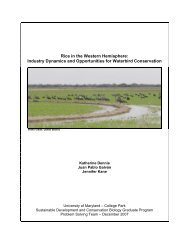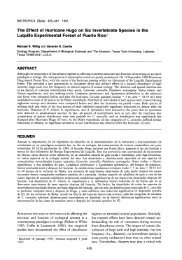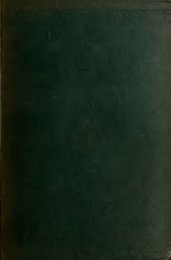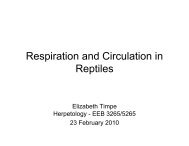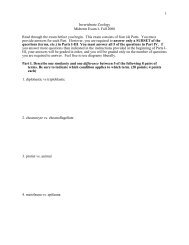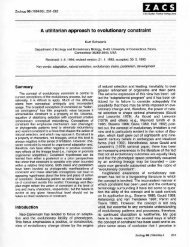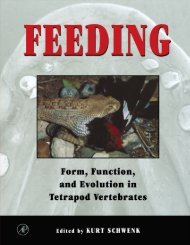aquatic macroinvertebrate diversity of playa wetlands: the ... - BioOne
aquatic macroinvertebrate diversity of playa wetlands: the ... - BioOne
aquatic macroinvertebrate diversity of playa wetlands: the ... - BioOne
You also want an ePaper? Increase the reach of your titles
YUMPU automatically turns print PDFs into web optimized ePapers that Google loves.
WETLANDS, Vol. 24, No. 1, March 2004, pp. 77–91<br />
2004, The Society <strong>of</strong> Wetland Scientists<br />
AQUATIC MACROINVERTEBRATE DIVERSITY OF PLAYA WETLANDS: THE<br />
ROLE OF LANDSCAPE AND ISLAND BIOGEOGRAPHIC CHARACTERISTICS<br />
Dianne L. Hall 1,3,6 , Michael R. Willig 1 , Daryl L. Moorhead 2 , Robert W. Sites 3 , Ernest B. Fish 4 , and<br />
Tony R. Mollhagen 5<br />
1 Ecology Program<br />
Department <strong>of</strong> Biological Sciences<br />
Texas Tech University<br />
Lubbock, Texas, USA 79409<br />
2 Department <strong>of</strong> Earth, Ecological and Environmental Sciences<br />
University <strong>of</strong> Toledo<br />
Toledo, Ohio, USA 43606<br />
3 Enns Entomology Museum<br />
Department <strong>of</strong> Entomology<br />
University <strong>of</strong> Missouri<br />
Columbia, Missouri, USA 65211<br />
4 Department <strong>of</strong> Range, Wildlife and Fisheries Management<br />
Texas Tech University<br />
Lubbock, Texas, USA 79409<br />
5 Water Resources Center<br />
Department <strong>of</strong> Civil Engineering<br />
Texas Tech University<br />
Lubbock, Texas, USA 79409<br />
6 Present address: Department <strong>of</strong> Water Resources<br />
St. Johns River Water Management District<br />
Palatka, Florida, USA 32178<br />
Abstract: Wetland habitats continue to be lost at a unsettling rate, especially freshwater emergent <strong>wetlands</strong><br />
that are isolated geographically. These are <strong>the</strong> predominant <strong>wetlands</strong> found in arid and semi-arid environments,<br />
where <strong>the</strong>y serve as foci <strong>of</strong> regional bio<strong>diversity</strong>. This is especially true <strong>of</strong> <strong>the</strong> <strong>playa</strong> <strong>wetlands</strong> <strong>of</strong> <strong>the</strong><br />
Sou<strong>the</strong>rn High Plains <strong>of</strong> Texas, USA. The factors that determine and maintain biotic <strong>diversity</strong> in <strong>the</strong>se<br />
<strong>wetlands</strong> are understood poorly. Consequently, this study examined <strong>the</strong> effect <strong>of</strong> island biogeographic and<br />
landscape features on <strong>the</strong> <strong>diversity</strong> <strong>of</strong> <strong>aquatic</strong> <strong>macroinvertebrate</strong>s in <strong>playa</strong> <strong>wetlands</strong>. Macroinvertebrates were<br />
collected from <strong>playa</strong>s three times during <strong>the</strong> spring and summer <strong>of</strong> 1994 and categorized as resident or<br />
transient taxa based on life history strategies. Diversity was estimated using taxonomic richness (richness)<br />
and Fisher’s log-series alpha (). Surrounding land-use practices influenced resident richness, whereas <strong>playa</strong><br />
surface area affected resident and transient richness, as well as resident . However, relationships differed<br />
among sampling dates. Regression analyses suggested that transient richness and were influenced more<br />
by insular characteristics than by landscape features. The converse was true for resident richness and .<br />
Therefore, both insular and landscape characteristics affected <strong>the</strong> <strong>diversity</strong> <strong>of</strong> <strong>macroinvertebrate</strong>s in <strong>playa</strong><br />
<strong>wetlands</strong>, but impacts were dependent on life-history strategy and time since inundation (i.e., sampling date).<br />
Consequently, conservation and management efforts targeting <strong>macroinvertebrate</strong>s in <strong>playa</strong> <strong>wetlands</strong> will need<br />
to focus on <strong>the</strong> <strong>wetlands</strong> and characteristics <strong>of</strong> adjacent watershed features.<br />
Key Words: <strong>playa</strong>s, <strong>wetlands</strong>, <strong>aquatic</strong> <strong>macroinvertebrate</strong>s, <strong>diversity</strong>, richness, <strong>the</strong>ory <strong>of</strong> island biogeography,<br />
landscape ecology, Sou<strong>the</strong>rn High Plains<br />
INTRODUCTION<br />
Despite <strong>the</strong> increase in wetland conservation efforts<br />
over <strong>the</strong> past two decades (Emergency Wetlands Resources<br />
Act 1986), substantial losses <strong>of</strong> <strong>wetlands</strong> con-<br />
77<br />
tinue (Dahl 2000). This is especially true for freshwater<br />
emergent <strong>wetlands</strong> (Dahl 2000), particularly<br />
those that are geographically isolated (i.e., surrounded<br />
by uplands; Tiner et al. 2002). Between 1986 and
78 WETLANDS, Volume 24, No. 1, 2004<br />
1997, approximately 486,000 hectares <strong>of</strong> freshwater<br />
emergent <strong>wetlands</strong> were converted to o<strong>the</strong>r uses (Dahl<br />
2000). Such <strong>wetlands</strong> are common in arid and semiarid<br />
regions and, consequently, are foci for bio<strong>diversity</strong><br />
in <strong>the</strong>se areas (Bolen et al. 1979, Holland and Jain<br />
1981, Haukos and Smith 1994, Brendonck and Williams<br />
2000, Tiner et al. 2002). Agriculture is one <strong>of</strong><br />
<strong>the</strong> major threats to <strong>wetlands</strong> in <strong>the</strong>se regions (Gu<strong>the</strong>ry<br />
and Bryant 1982, Grue et al. 1986), with 51% <strong>of</strong> <strong>the</strong><br />
losses in emergent <strong>wetlands</strong> from 1986 to 1997 attributable<br />
to agriculture (Dahl 2000). Given <strong>the</strong> importance<br />
<strong>of</strong> <strong>the</strong>se <strong>wetlands</strong> to regional bio<strong>diversity</strong> (Brendock<br />
and Williams 2000), it is important to determine<br />
<strong>the</strong> factors that shape and maintain <strong>the</strong> bio<strong>diversity</strong> <strong>of</strong><br />
<strong>the</strong>se <strong>wetlands</strong>; o<strong>the</strong>rwise, prudent policies for <strong>the</strong>ir<br />
conservation and management will remain illusive<br />
(Hughes and Hunsaker 2002).<br />
Playas <strong>of</strong> <strong>the</strong> Sou<strong>the</strong>rn High Plains, USA are examples<br />
<strong>of</strong> isolated, freshwater emergent <strong>wetlands</strong> that<br />
continue to be threatened by agricultural activities.<br />
These shallow basins are a conspicuous part <strong>of</strong> <strong>the</strong><br />
landscape, with more than 19,000 <strong>playa</strong>s occurring on<br />
<strong>the</strong> Llano Estacado or Sou<strong>the</strong>rn High Plains region <strong>of</strong><br />
Texas (Playa Lakes Joint Venture 1993). Playas are<br />
<strong>the</strong> predominant surface hydrologic feature and are important<br />
for ground-water recharge into <strong>the</strong> underlying<br />
Ogallala Aquifer (Zartman et al. 1994, 1996, Scanlon<br />
and Goldsmith 1997). The land around <strong>playa</strong>s is<br />
among <strong>the</strong> most intensively cultivated areas in <strong>the</strong><br />
United States (Bolen et al. 1979). Consequently, most<br />
<strong>of</strong> <strong>the</strong>se <strong>wetlands</strong> are strongly modified by agricultural<br />
activities (Gu<strong>the</strong>ry and Bryant 1982, Bolen et al. 1989,<br />
Luo et al. 1997, Luo and Smith 1999).<br />
As <strong>wetlands</strong> in a semi-arid environment, <strong>playa</strong>s are<br />
<strong>the</strong> major habitat for a pr<strong>of</strong>usion <strong>of</strong> <strong>aquatic</strong> and wetland<br />
plants (Haukos and Smith 1997). They serve as<br />
breeding areas for numerous birds, amphibians, and<br />
<strong>macroinvertebrate</strong>s (Bolen 1982, Seyffert 1985, Anderson<br />
et al. 1999, Hall et al. 1999) and are important<br />
as stopover points for migrating waterfowl, cranes, and<br />
shorebirds using <strong>the</strong> Central Flyway <strong>of</strong> <strong>the</strong> United<br />
States (U. S. Fish and Wildlife Service 1988, Haukos<br />
and Smith 1994, Davis and Smith 1998). Although<br />
less frequently studied than plants and birds, <strong>aquatic</strong><br />
<strong>macroinvertebrate</strong>s are one <strong>of</strong> <strong>the</strong> most diverse and<br />
abundant groups <strong>of</strong> organisms in <strong>the</strong>se <strong>wetlands</strong> (Sublette<br />
and Sublette 1967, Parks 1975, Merickel and<br />
Wangberg 1981, Hall 1997, Hall et al. 1999, Anderson<br />
and Smith 2000). They appear in <strong>playa</strong>s within days<br />
<strong>of</strong> inundation and quickly become abundant, occupying<br />
many trophic levels (Hall et al. 1999). Thus, <strong>macroinvertebrate</strong>s<br />
are important trophic components <strong>of</strong><br />
<strong>the</strong>se ecosystems. Most research on <strong>aquatic</strong> <strong>macroinvertebrate</strong>s<br />
in <strong>playa</strong>s has focused on <strong>the</strong>ir importance<br />
as food resources for migrating waterfowl and shore-<br />
birds (Baldassarre and Fischer 1984, Sheeley 1988,<br />
Davis and Smith 1998). Given <strong>the</strong>ir abundance and<br />
<strong>diversity</strong> in <strong>the</strong>se <strong>wetlands</strong>, it is surprising how little<br />
is known about <strong>the</strong> factors that affect <strong>macroinvertebrate</strong>s.<br />
Because <strong>playa</strong>s are <strong>aquatic</strong> islands within a terrestrial<br />
matrix, island biogeography (MacArthur and Wilson<br />
1967) and landscape ecology (Naveh and Liberman<br />
1983, Risser et al. 1984) provide conceptual bases<br />
for studying <strong>macroinvertebrate</strong> <strong>diversity</strong> and colonization.<br />
The <strong>the</strong>ory <strong>of</strong> island biogeography predicts that<br />
size <strong>of</strong> an island and its proximity to a source <strong>of</strong> colonists<br />
determine <strong>the</strong> equilibrium number <strong>of</strong> species on<br />
an island, with larger islands and those nearer a source<br />
<strong>of</strong> colonists harboring more species than smaller or<br />
more distant islands. Although originally proposed to<br />
account for differences in species <strong>diversity</strong> on oceanic<br />
islands, <strong>the</strong> tenets <strong>of</strong> island biogeography have been<br />
used to explain successfully <strong>the</strong> differences in species<br />
<strong>diversity</strong> among mountain tops (Brown 1971), urban<br />
parks (Gavareski 1976), lakes (Fryer 1985), vernal<br />
pools (Ebert and Balko 1987), individual leaves (Andrews<br />
et al. 1987), and carrion (Doube 1987). Similarly,<br />
insular characteristics such as island area and<br />
proximity to sources <strong>of</strong> colonists that provide <strong>the</strong> basis<br />
for island biogeography <strong>the</strong>ory could help explain differences<br />
in <strong>aquatic</strong> <strong>macroinvertebrate</strong> <strong>diversity</strong> among<br />
<strong>playa</strong> <strong>wetlands</strong>.<br />
As a complementary view, landscape ecology emphasizes<br />
<strong>the</strong> influence <strong>of</strong> <strong>the</strong> surrounding matrix on<br />
species <strong>diversity</strong> <strong>of</strong> habitat islands (Harris 1984). Indeed,<br />
characteristics <strong>of</strong> <strong>the</strong> surrounding landscape <strong>of</strong>ten<br />
have a considerable effect on insular species <strong>diversity</strong><br />
(Tilghman 1987, Green et al. 1994, Natuhara<br />
et al. 1999). In some instances, <strong>the</strong> surrounding landscape<br />
has been more important than <strong>the</strong> size <strong>of</strong> a habitat<br />
in determining its species <strong>diversity</strong> (Webb et al.<br />
1984). The landscape perspective also may be relevant<br />
in determining <strong>the</strong> <strong>diversity</strong> <strong>of</strong> <strong>aquatic</strong> <strong>macroinvertebrate</strong>s<br />
in <strong>playa</strong> <strong>wetlands</strong> because land-use characteristics<br />
can have pr<strong>of</strong>ound effects on <strong>the</strong> biota <strong>of</strong> waterbodies<br />
(Newbold et al. 1980, Rundle and Ormerod<br />
1991, Ormerod et al. 1993, Rundle and Attrill 1995,<br />
Townsend et al. 1997).<br />
These two perspectives are not mutually exclusive.<br />
MacArthur and Wilson (1967) realized that differences<br />
in <strong>the</strong> matrices between islands, such as prevailing<br />
winds, water currents, and climate, affected species <strong>diversity</strong>.<br />
Similarly, landscape ecology (Forman 1995)<br />
recognizes <strong>the</strong> importance <strong>of</strong> habitat size and <strong>the</strong> spatial<br />
distribution <strong>of</strong> habitats. Species <strong>diversity</strong> likely results<br />
from a combination <strong>of</strong> insular and landscape factors.<br />
If landscape characteristics are most important,<br />
differences in <strong>diversity</strong> <strong>of</strong> <strong>aquatic</strong> organisms in <strong>playa</strong>s<br />
should reflect surrounding land uses and watershed at-
Hall et al., MACROINVERTEBRATE DIVERSITY OF PLAYA WETLANDS 79<br />
Figure 1. Locations <strong>of</strong> sampled <strong>playa</strong>s on <strong>the</strong> Sou<strong>the</strong>rn<br />
High Plains <strong>of</strong> Texas, USA.<br />
tributes. However, if insular characteristics are more<br />
important, <strong>diversity</strong> should be influenced by ‘‘island’’<br />
characteristics such as depth, areal extent <strong>of</strong> <strong>the</strong> surface<br />
water, and <strong>the</strong> number and proximity <strong>of</strong> surrounding<br />
<strong>playa</strong>s. The objective <strong>of</strong> this study was to examine<br />
<strong>the</strong> effects <strong>of</strong> insular and landscape characteristics on<br />
two aspects <strong>of</strong> <strong>the</strong> <strong>diversity</strong> <strong>of</strong> <strong>aquatic</strong> <strong>macroinvertebrate</strong>s<br />
in <strong>playa</strong> <strong>wetlands</strong> (taxa richness and Fisher’s<br />
log-series ) and <strong>the</strong>reby elucidate <strong>the</strong> determinants <strong>of</strong><br />
<strong>macroinvertebrate</strong> <strong>diversity</strong> in <strong>playa</strong>s.<br />
Study Area<br />
METHODS<br />
Playas from a four-county area adjacent to and including<br />
Lubbock County, Texas, USA (latitude, 33<br />
20 Nto34 20 N; longitude, 102 45 W to 101 00<br />
W) were sampled for <strong>macroinvertebrate</strong>s three times<br />
over an eight-week period, <strong>the</strong> approximate duration<br />
<strong>of</strong> inundation, during <strong>the</strong> spring and summer <strong>of</strong> 1994<br />
(Figure 1). Classification <strong>of</strong> <strong>playa</strong>s was based on size<br />
<strong>of</strong> basin (i.e., extent <strong>of</strong> <strong>the</strong> underlying layer <strong>of</strong> Randall<br />
clay) and surrounding land use. Geographic information<br />
for each <strong>playa</strong> basin and watershed was developed<br />
by digitizing <strong>the</strong> <strong>playa</strong>s from Natural Resource Conservation<br />
Service county soil survey maps (GIS; ARC/<br />
INFO, Environmental Systems Research Institute, Inc.<br />
Redlands, CA). United States Geological Survey 7.5minute<br />
topographic quadrangle maps were used for<br />
geographic control. Land-use information was obtained<br />
from aerial photographs, taken twice a year for<br />
crop evaluation purposes, and data from <strong>the</strong> Farm Service<br />
Agency <strong>of</strong>fices in each county. This information<br />
was <strong>the</strong>n ground-tru<strong>the</strong>d to verify <strong>the</strong> interpretation <strong>of</strong><br />
<strong>the</strong> imagery.<br />
Three main types <strong>of</strong> land use predominate on <strong>the</strong><br />
Sou<strong>the</strong>rn High Plains: agricultural crops (AGR),<br />
rangeland (RNG), and grasslands in <strong>the</strong> Conservation<br />
Reserve Program (CRP). Agricultural practices consist<br />
<strong>of</strong> crops such as sorghum, cotton, and wheat. The Conservation<br />
Reserve Program (Food Security Act 1985)<br />
was established to encourage farmers to remove highly<br />
erodible soil from agriculture and to plant native vegetation<br />
in its place. On <strong>the</strong> Sou<strong>the</strong>rn High Plains <strong>of</strong><br />
Texas, <strong>the</strong> native vegetation is grassland. However,<br />
grazing is prohibited on CRP grasslands. Because <strong>of</strong><br />
<strong>the</strong> unpredictable flooding <strong>of</strong> <strong>playa</strong>s, many farmers<br />
have entered lands surrounding <strong>playa</strong>s into <strong>the</strong> CRP.<br />
Playas were classified based on <strong>the</strong> predominant<br />
(50 percent <strong>of</strong> area) land use (AGR, RNG, CRP)<br />
within 100 m <strong>of</strong> <strong>the</strong> perimeter <strong>of</strong> <strong>the</strong> basin. Three size<br />
categories were distinguished within each land-use<br />
group: small <strong>playa</strong> basins were 10 ha, medium basins<br />
ranged from 10 to 20 ha, and large basins were<br />
20 and 33 ha. These size categories encompassed<br />
approximately 98 percent <strong>of</strong> <strong>playa</strong>s in <strong>the</strong> four-county<br />
area <strong>of</strong> this study. Playas also were classified by size<br />
according to water surface area at each time period.<br />
Because <strong>the</strong> areal extent <strong>of</strong> water and <strong>the</strong> number <strong>of</strong><br />
sampled <strong>playa</strong>s changed with time, <strong>playa</strong>s were assigned<br />
to one <strong>of</strong> three groups (small, medium, and<br />
large) based on <strong>the</strong>ir position in <strong>the</strong> overall size distribution<br />
<strong>of</strong> <strong>playa</strong>s within each sampling period (i.e.,<br />
lower, middle, or upper third, respectively; Table 1).<br />
Estimation <strong>of</strong> <strong>playa</strong> surface area was based on <strong>the</strong><br />
position <strong>of</strong> <strong>the</strong> water’s edge, marked with stakes<br />
placed at each cardinal point soon after initial inundation.<br />
Playas were assumed to dry uniformly. Because<br />
most <strong>playa</strong>s are slightly elliptical (Reeves<br />
1966), surface area was calculated as <strong>the</strong> area <strong>of</strong> an<br />
ellipse,<br />
A L W/4<br />
where L is <strong>the</strong> length <strong>of</strong> <strong>the</strong> longest axis <strong>of</strong> <strong>the</strong> <strong>playa</strong><br />
and W is <strong>the</strong> length <strong>of</strong> <strong>the</strong> perpendicular axis. Surface<br />
area was calculated for each <strong>playa</strong> at each sampling<br />
period. In addition, average water depth and a visual
80 WETLANDS, Volume 24, No. 1, 2004<br />
Table 1. Areal extent (*hectares) <strong>of</strong> <strong>playa</strong> surface water used to categorize <strong>playa</strong>s as small, medium, and large in each sampling period.<br />
The number <strong>of</strong> <strong>playa</strong>s in each category is enclosed by paren<strong>the</strong>ses. Sampling period 1, May 26–June 7; period 2, June 20–28; period 3,<br />
July 11–14 (1994).<br />
Period<br />
1<br />
2<br />
3<br />
Size Categories<br />
Small Medium Large<br />
3.31–6.34 (13)<br />
2.23–3.76 (9)<br />
0.98–2.48 (4)<br />
estimate <strong>of</strong> <strong>the</strong> percentage <strong>of</strong> <strong>the</strong> <strong>playa</strong> surface covered<br />
by emergent vegetation were recorded during each<br />
sampling period. An estimate <strong>of</strong> emergent vegetative<br />
cover was used because a quantitative floristic survey<br />
<strong>of</strong> <strong>the</strong>se <strong>wetlands</strong> was beyond <strong>the</strong> scope <strong>of</strong> this project<br />
(Wood et al. 2001).<br />
Invertebrate Collection and Identification<br />
Sampling began approximately three weeks after<br />
<strong>playa</strong>s were inundated by spring storms (Hall 1997).<br />
At each sampling, 50 points were located at random<br />
within each <strong>playa</strong> using random number tables to indicate<br />
<strong>the</strong> direction <strong>of</strong> <strong>the</strong> transect and <strong>the</strong> distance<br />
between consecutives samples. At each point, two surface,<br />
six subsurface, and five benthic samples were<br />
taken, resulting in 100 surface, 300 subsurface, and<br />
250 benthic samples per <strong>playa</strong>. This protocol was<br />
based on preliminary sampling <strong>of</strong> a <strong>playa</strong> not included<br />
in this study. An <strong>aquatic</strong> D-net was used for surface<br />
and subsurface samples, and a single-bore corer (2’’<br />
inner diameter) was used for benthic samples (Hall<br />
1997).<br />
Initially, <strong>macroinvertebrate</strong>s from surface and subsurface<br />
samples were preserved in 95 percent ethanol,<br />
whereas benthic samples were preserved in 10 percent<br />
formalin. After <strong>macroinvertebrate</strong>s were separated<br />
from debris and sediment, all specimens were transferred<br />
to 80 percent ethanol. Individuals were identified<br />
to <strong>the</strong> specific level when possible (Appendix 1).<br />
Voucher specimens were deposited in <strong>the</strong> Enns Entomology<br />
Museum, University <strong>of</strong> Missouri-Columbia,<br />
<strong>the</strong> Illinois Natural History Survey Annelida Collection,<br />
Champaign (Oligochaeta), and <strong>the</strong> Aquatic Insect<br />
Collection <strong>of</strong> <strong>the</strong> Kansas Biological Survey, Lawrence<br />
(Chironomidae).<br />
Statistical Analyses<br />
Because <strong>playa</strong> lakes are ephemeral, <strong>the</strong>ir <strong>aquatic</strong> inhabitants<br />
have developed strategies for enduring or<br />
avoiding periods <strong>of</strong> desiccation (Wiggins et al. 1980).<br />
Macroinvertebrate inhabitants were categorized into<br />
two groups based on <strong>the</strong>se strategies. Residents are<br />
6.49–10.01 (12)<br />
3.95–6.16 (8)<br />
3.39–4.62 (3)<br />
11.58–23.44 (13)<br />
7.22–18.15 (8)<br />
4.87–9.82 (3)<br />
organisms with drought-resistant life stages that usually<br />
have no autonomous means <strong>of</strong> emigration or immigration.<br />
In contrast, transients are organisms that,<br />
for <strong>the</strong> most part, have limited or no drought-resistant<br />
life stages and are capable <strong>of</strong> active movement between<br />
<strong>playa</strong>s during <strong>the</strong>ir life cycle, usually as flying<br />
adults. Because <strong>the</strong>se differences in dispersal ability<br />
could be paralleled by differences in response to insular<br />
or landscape characteristics (Batzer and Wissinger<br />
1996), resident and transient taxa were analyzed<br />
separately. To avoid problems associated with successional<br />
changes in <strong>macroinvertebrate</strong> composition<br />
(Moorhead et al. 1998), separate statistical analyses<br />
were conducted for each sampling date.<br />
Taxonomic <strong>diversity</strong> was evaluated in two ways: as<br />
taxonomic richness (<strong>the</strong> number <strong>of</strong> distinguishable<br />
species, morphospecies, or higher taxonomic groups;<br />
Appendix 1) and as Fisher’s log-series (Fisher et al.<br />
1943), which is sensitive to richness and <strong>the</strong> abundance<br />
<strong>of</strong> species. The latter index assumes an underlying<br />
log-series species abundance distribution but is<br />
robust with respect to deviations from that distribution<br />
(Taylor 1978). Fisher’s log-series (Magurran 1988)<br />
is calculated as<br />
[N (1 x)]/x,<br />
where x is estimated by <strong>the</strong> iterative solution <strong>of</strong><br />
S/N {(1x)/x}{ln (1 x) }<br />
and S is <strong>the</strong> number <strong>of</strong> species, morphospecies, or<br />
higher taxa, with N equal to <strong>the</strong> number <strong>of</strong> individuals.<br />
Fisher’s log-series is not unduly influenced by sample<br />
size, and an underlying log-series distribution is<br />
more applicable than o<strong>the</strong>rs, given <strong>the</strong> ephemeral nature<br />
<strong>of</strong> <strong>playa</strong> lakes and <strong>the</strong> resultant adaptations <strong>of</strong><br />
<strong>the</strong>ir faunas (Hall 1997). Never<strong>the</strong>less, <strong>the</strong> species<br />
abundance distribution <strong>of</strong> each <strong>playa</strong> in each time period<br />
was tested for deviations from a log-series distribution<br />
via Chi-square goodness <strong>of</strong> fit analysis to verify<br />
<strong>the</strong> appropriateness <strong>of</strong> Fisher’s log-series as an index<br />
<strong>of</strong> <strong>macroinvertebrate</strong> <strong>diversity</strong> in <strong>playa</strong> lakes (Magurran<br />
1988).<br />
Several multivariate analyses were used to elucidate<br />
<strong>the</strong> effect <strong>of</strong> insular and landscape characteristics on
Hall et al., MACROINVERTEBRATE DIVERSITY OF PLAYA WETLANDS 81<br />
Table 2. Insular and landscape characteristics used in multiple regression<br />
analyses.<br />
Insular Characteristics<br />
Average size <strong>of</strong> <strong>the</strong> <strong>playa</strong>s within a three km radius<br />
Average water depth<br />
Distance to <strong>the</strong> nearest <strong>playa</strong><br />
Number <strong>of</strong> excavated pits in <strong>the</strong> <strong>playa</strong><br />
Percent <strong>of</strong> <strong>the</strong> <strong>playa</strong> surface area with emergent vegetation<br />
Size <strong>of</strong> <strong>the</strong> nearest <strong>playa</strong> (based on basin size)<br />
Total number <strong>of</strong> <strong>playa</strong>s in a three km radius<br />
Total area <strong>of</strong> <strong>playa</strong>s (based on basin sizes) within a three km<br />
radius<br />
Landscape Characteristics<br />
Number <strong>of</strong> culverts draining into <strong>the</strong> <strong>playa</strong><br />
Number <strong>of</strong> roads in <strong>the</strong> watershed<br />
Percent <strong>of</strong> <strong>the</strong> watershed in cotton<br />
Percent <strong>of</strong> <strong>the</strong> watershed in <strong>the</strong> Conservation Reserve Program<br />
Percent <strong>of</strong> <strong>the</strong> watershed in rangeland<br />
Percent <strong>of</strong> <strong>the</strong> watershed in sorghum<br />
Percent <strong>of</strong> <strong>the</strong> watershed in wheat<br />
Size <strong>of</strong> <strong>the</strong> watershed<br />
Slope <strong>of</strong> <strong>the</strong> watershed<br />
taxonomic richness and Fisher’s log-series (hereafter<br />
referred to as richness and , respectively) The effects<br />
<strong>of</strong> <strong>playa</strong> size and surrounding land use (AGR, CRP,<br />
RNG) on richness or were assessed separately during<br />
each time period using analysis <strong>of</strong> covariance (Procedure<br />
ANOVA, SPSS Inc. 1990). Covariates (surface<br />
area <strong>of</strong> <strong>the</strong> <strong>playa</strong> and basin size) were used because<br />
resident and transient taxa have disparate colonization<br />
abilities. Because resident taxa withstand periods <strong>of</strong><br />
desiccation and do not emigrate when <strong>playa</strong>s dry, <strong>the</strong><br />
size <strong>of</strong> <strong>the</strong> basin (i.e., <strong>the</strong> extent <strong>of</strong> <strong>the</strong> available refuge)<br />
might be important. However, most transient taxa<br />
must immigrate to a <strong>playa</strong> after <strong>the</strong> <strong>playa</strong> fills; consequently,<br />
<strong>the</strong> areal extent <strong>of</strong> <strong>the</strong> surface water might<br />
be an important cue for <strong>the</strong>se taxa (Fernando 1959).<br />
Stepwise multiple regression was used to assess <strong>the</strong><br />
combined effects <strong>of</strong> insular and landscape characteristics<br />
on richness and (Procedure REGRESSION,<br />
SPSS Inc. 1990). Eight insular and nine landscape<br />
characteristics (Table 2) were used as independent variables.<br />
Insular characteristics included those variables<br />
concerned with physical aspects <strong>of</strong> <strong>the</strong> <strong>playa</strong> or <strong>the</strong><br />
distribution and size <strong>of</strong> surrounding <strong>playa</strong>s that might<br />
affect <strong>macroinvertebrate</strong> colonization. Conversely,<br />
landscape characteristics were attributes <strong>of</strong> <strong>the</strong> intervening<br />
matrix surrounding each <strong>playa</strong> (i.e., <strong>the</strong> <strong>playa</strong>’s<br />
watershed).<br />
An increased probability <strong>of</strong> committing a Type I<br />
error occurs when considering multiple statistical tests.<br />
To minimize this likelihood, Bonferroni’s sequential<br />
adjustment (Rice 1989) was used to evaluate <strong>the</strong> sig-<br />
nificance <strong>of</strong> independent variables in determining <strong>the</strong><br />
factors associated with variation in dependent variables<br />
(e.g., resident or transient richness).<br />
Richness<br />
RESULTS<br />
Approximately 190,000 individuals representing<br />
107 taxa were collected in this study. These taxa represented<br />
81 genera, 47 families, 13 orders, 7 classes,<br />
and 3 phyla (Appendix 1). Richness differed over time<br />
and with life history strategy. Overall <strong>macroinvertebrate</strong><br />
richness ranged from 23.6 to 32.6, depending on<br />
sampling period, with <strong>the</strong> greatest values achieved during<br />
<strong>the</strong> second sampling period. Richness <strong>of</strong> resident<br />
taxa ranged from 7.2 to 9.8, and was greatest during<br />
<strong>the</strong> first and second sampling periods. Richness <strong>of</strong><br />
transient taxa ranged from 13.8 to 22.8 and was greatest<br />
during <strong>the</strong> second and third sampling periods.<br />
These trends in taxa richness generally were consistent<br />
regardless <strong>of</strong> land use or size <strong>of</strong> <strong>playa</strong>s.<br />
The effects <strong>of</strong> land use, basin size, and surface area<br />
on richness varied over time and between resident and<br />
transient faunas. Differences in surrounding land use<br />
accounted for significant variation in resident richness<br />
after <strong>the</strong> effects <strong>of</strong> <strong>playa</strong> area and basin size were removed<br />
but only during <strong>the</strong> first sampling period (AN-<br />
COVA; F 4.306; P 0.022; df 2,33). Average<br />
resident richness was greatest in <strong>playa</strong>s surrounded by<br />
rangeland and lowest in <strong>playa</strong>s surrounded by agriculture.<br />
Transient richness was not associated significantly<br />
with surrounding land use in any sampling period.<br />
Resident and transient richness were associated significantly<br />
with covariates during <strong>the</strong> second and third<br />
sampling periods, respectively. During <strong>the</strong> second<br />
sampling period, resident richness was associated negatively<br />
with <strong>playa</strong> surface area (F 7.033; P 0.015;<br />
df 1,20); <strong>the</strong> positive relationship between transient<br />
richness and basin size was intriguing but was not significant<br />
(F 3.902; P 0.062; df 1,20). During<br />
<strong>the</strong> third sampling period, transient richness was related<br />
negatively to <strong>playa</strong> surface area (F 10.559; P<br />
0.023; df 1,5), but resident richness showed no<br />
relationship to ei<strong>the</strong>r covariate.<br />
A combination <strong>of</strong> insular and landscape characteristics<br />
contributed to variation in richness. During <strong>the</strong><br />
first sampling period, a significant amount <strong>of</strong> variation<br />
in transient richness was attributed positively to <strong>the</strong><br />
amount <strong>of</strong> emergent <strong>playa</strong> vegetation (r 2 0.35) and<br />
negatively to <strong>the</strong> number <strong>of</strong> culverts (r 2 0.11) draining<br />
into <strong>the</strong> <strong>playa</strong> (Model R 2 0.46, P 0.001). In<br />
contrast, resident richness was not significantly related<br />
to any <strong>of</strong> <strong>the</strong> insular or landscape characteristics during
82 WETLANDS, Volume 24, No. 1, 2004<br />
Table 3. Significant relationships between <strong>diversity</strong> variables and variables used in ANCOVA and stepwise multiple regression analyses<br />
in each sampling period. (IB island biogeographic variable; L landscape variable).<br />
Diversity Variable<br />
Resident richness<br />
Resident <br />
Transient richness<br />
Transient <br />
Sampling<br />
Period<br />
1<br />
2<br />
3<br />
1<br />
2<br />
3<br />
1<br />
2<br />
3<br />
1<br />
2<br />
3<br />
L<br />
Land use<br />
ANCOVA Variables<br />
Basin<br />
Size<br />
<strong>the</strong> first sampling period. During <strong>the</strong> second sampling<br />
period, transient richness was associated positively<br />
with <strong>the</strong> amount <strong>of</strong> <strong>playa</strong> vegetation (r 2 0.08) and<br />
negatively to average water depth and <strong>the</strong> abundance<br />
<strong>of</strong> roads (r 2 0.16) in <strong>the</strong> watershed (Model R 2 <br />
0.76, P 0.001). Examination <strong>of</strong> parital correlation<br />
coefficients revealed a significant positive correlation<br />
between water depth and <strong>the</strong> amount <strong>of</strong> <strong>the</strong> watershed<br />
planted in winter wheat. However, depth accounted for<br />
over twice <strong>the</strong> amount <strong>of</strong> unique variation in transient<br />
richness compared to winter wheat during this period<br />
(r 2 0.52 and 0.24, respectively). Resident richness<br />
was affected positively by <strong>the</strong> size <strong>of</strong> <strong>the</strong> nearest <strong>playa</strong><br />
(Model R 2 0.22, P 0.018). During <strong>the</strong> third sampling<br />
period, transient richness was associated negatively<br />
with average water depth (Model R 2 0.56 P<br />
0.013), whereas resident richness showed no significant<br />
relationship with insular or landscape characteristics.<br />
1B<br />
Playa<br />
Area<br />
Diversity<br />
Chi-square analyses revealed that Fisher’s log-series<br />
was an appropriate <strong>diversity</strong> index to characterize<br />
<strong>playa</strong> lakes. Depending on sampling period, 90–96%<br />
<strong>of</strong> <strong>playa</strong>s had taxon abundance distributions that were<br />
not significantly different from a log-series distribution<br />
(P 0.05).<br />
Fisher’s log-series varied over time and differed<br />
between resident and transient faunas. Overall <strong>macroinvertebrate</strong><br />
ranged from 4.2 to 5.6 and was greatest<br />
during <strong>the</strong> second sampling period. Resident <br />
x<br />
Avg.<br />
Playa<br />
Size in<br />
3km<br />
Radium<br />
Average<br />
Water<br />
Depth<br />
Multiple Regression Variables<br />
Distance<br />
to<br />
Nearest<br />
Playa<br />
1B<br />
Number<br />
<strong>of</strong> Pits<br />
in Playa<br />
%<br />
Emergent<br />
Vegetation<br />
Size <strong>of</strong><br />
Nearest<br />
Playa<br />
x x<br />
x<br />
x<br />
x<br />
x<br />
x<br />
ranged from 1.4 to 2.2 and was greatest during <strong>the</strong><br />
second sampling period. In contrast, transient remained<br />
essentially constant, between 3.9 and 4.0<br />
across sampling periods.<br />
Even after <strong>the</strong> removal <strong>of</strong> variation due to <strong>playa</strong><br />
size, differences in surrounding land use never accounted<br />
for significant variation in , based on analysis<br />
<strong>of</strong> covariance. During <strong>the</strong> first sampling period,<br />
resident (after Bonferroni adjustment) approached<br />
significance with <strong>playa</strong> surface area (F 4.936; P <br />
0.033; df 1,33; adjusted P must be 0.025 to be<br />
considered significant) and <strong>the</strong> relationship was positive.<br />
However, this relationship was not found in <strong>the</strong><br />
second or third sampling periods. Similarly, transient<br />
was not associated with ei<strong>the</strong>r covariate in any sampling<br />
period.<br />
Variation in usually was attributed to a combination<br />
<strong>of</strong> insular and landscape characteristics based<br />
on stepwise multiple regression analyses. In <strong>the</strong> first<br />
sampling period, resident was associated positively<br />
with <strong>the</strong> percent <strong>of</strong> <strong>the</strong> watershed containing sorghum<br />
(Model R 2 0.36, P 0.001), whereas transient <br />
was related positively to <strong>the</strong> amount <strong>of</strong> emergent <strong>playa</strong><br />
vegetation (Model R 2 0.25, P 0.002). During <strong>the</strong><br />
second sampling period, resident again was associated<br />
positively with <strong>the</strong> percentage <strong>of</strong> <strong>the</strong> watershed<br />
planted in sorghum (Model R 2 0.31, P 0.004),<br />
whereas transient was related positively to <strong>the</strong><br />
amount <strong>of</strong> emergent <strong>playa</strong> vegetation (r 2 0.43) and<br />
negatively with average water depth (r 2 0.12) in <strong>the</strong><br />
<strong>playa</strong> (Model R 2 0.55, P 0.001). As was seen<br />
x<br />
x<br />
x<br />
x
Hall et al., MACROINVERTEBRATE DIVERSITY OF PLAYA WETLANDS 83<br />
Table 3. Extended<br />
IB<br />
Number <strong>of</strong> Area <strong>of</strong><br />
Playas in 3 Playas in 3<br />
km Radius km Radius<br />
Number <strong>of</strong><br />
Culverts<br />
into Playa<br />
x<br />
Number <strong>of</strong><br />
Roads in<br />
Watershed<br />
Multiple Regression Variables<br />
%<strong>of</strong><br />
Watershed<br />
in Cotton<br />
with transient richness, <strong>playa</strong> depth and <strong>the</strong> extent <strong>of</strong><br />
watershed planted in winter wheat were significantly<br />
and positively correlated, but depth accounted for<br />
more <strong>of</strong> <strong>the</strong> unique variation in transient than did<br />
winter wheat (r 2 0.34 and 0.26, respectively). In <strong>the</strong><br />
third sampling period, transient was related negatively<br />
with average water depth (r 2 0.59) and positively<br />
to <strong>the</strong> percentage <strong>of</strong> <strong>the</strong> watershed planted with<br />
sorghum (r 2 0.19; Model R 2 0.78, P 0.005).<br />
Resident was positively related to <strong>the</strong> slope <strong>of</strong> <strong>the</strong><br />
watershed (Model R 2 0.47, P 0.028).<br />
DISCUSSION<br />
Playa lakes host a diverse <strong>macroinvertebrate</strong> fauna<br />
despite <strong>the</strong>ir temporary nature and <strong>the</strong> requisite physiological<br />
adaptations <strong>of</strong> <strong>the</strong>ir <strong>aquatic</strong> inhabitants. In<br />
fact, <strong>the</strong>y harbor a greater number <strong>of</strong> species, families,<br />
orders, and classes than do permanently flooded <strong>playa</strong>s<br />
that have been incorporated into stormwater systems<br />
<strong>of</strong> local municipalities in west Texas (Wolf 1996).<br />
This <strong>diversity</strong>, as measured by taxonomic richness and<br />
Fisher’s log series , is attributable to both insular and<br />
landscape characteristics. Overall, taxonomic richness<br />
seemed to be more influenced by characteristics <strong>of</strong> <strong>the</strong><br />
<strong>playa</strong>s <strong>the</strong>mselves, and taxonomic <strong>diversity</strong> (<strong>the</strong> distribution<br />
<strong>of</strong> individuals among taxa) seemed to be<br />
more effected by characteristics <strong>of</strong> <strong>the</strong> surrounding watershed<br />
(Table 3). However, <strong>the</strong>se relationships are dependent<br />
on both <strong>the</strong> time since inundation and <strong>the</strong> dispersal<br />
strategies <strong>of</strong> <strong>the</strong> wetland taxa.<br />
Resident taxa seemed to be more sensitive to land-<br />
x<br />
%<strong>of</strong><br />
Watershed<br />
in CRP<br />
L<br />
%<strong>of</strong><br />
Watershed<br />
in<br />
Rangeland<br />
%<strong>of</strong><br />
Watershed<br />
in Sorghum<br />
x<br />
x<br />
x<br />
%<strong>of</strong><br />
Watershed<br />
in Winter<br />
Wheat<br />
Size <strong>of</strong><br />
Watershed<br />
Slope <strong>of</strong><br />
Watershed<br />
scape characteristics than were transient taxa (Table<br />
3). Because resident taxa cannot migrate between basins,<br />
land use and landscape characteristics within watersheds<br />
might reasonably show stronger effects on<br />
resident taxa than on transients. Moreover, <strong>the</strong> influence<br />
<strong>of</strong> landscape characteristics on resident taxa was<br />
most apparent during early inundation when resident<br />
taxa were most abundant (Hall 1997). Recent work by<br />
Luo et al. (1997) linked increased sedimentation <strong>of</strong><br />
<strong>playa</strong>s, based on sediment depth and loss <strong>of</strong> <strong>playa</strong> volume,<br />
to cultivation within <strong>the</strong> watershed and suggested<br />
that sedimentation was a serious threat to <strong>playa</strong> <strong>wetlands</strong>.<br />
Indeed, sedimentation may decrease hatching<br />
success <strong>of</strong> resident taxa by deeply burying resting stages<br />
(Takahashi 1977, Scott and Grigarick 1979), <strong>the</strong>reby<br />
affecting overall <strong>macroinvertebrate</strong> <strong>diversity</strong> (Euliss<br />
and Mushet 1999); this relationship, however, has not<br />
been studied in <strong>playa</strong> <strong>wetlands</strong>. Euliss and Mushet<br />
(1996) and van der Kamp et al. (1999) have shown<br />
greater run<strong>of</strong>f from cultivated watersheds than from<br />
those supporting grasslands. If increased run<strong>of</strong>f leads<br />
to permanent inundation <strong>of</strong> <strong>playa</strong>s, resident taxa that<br />
depend on a period <strong>of</strong> desiccation for phenological development<br />
will not persist. It is unlikely that agriculture<br />
within <strong>playa</strong> watersheds will cease, but <strong>the</strong> establishment<br />
<strong>of</strong> a buffer zone <strong>of</strong> perennial, native vegetation<br />
adjacent to <strong>playa</strong>s could both reduce sedimentation<br />
and surface-water run<strong>of</strong>f from cropland<br />
watersheds (Haukos 1994, Luo et al. 1997, Luo and<br />
Smith 1999) and <strong>the</strong>reby enhance <strong>diversity</strong> <strong>of</strong> resident<br />
<strong>macroinvertebrate</strong>s.<br />
x
84 WETLANDS, Volume 24, No. 1, 2004<br />
Transient taxa were more influenced by insular<br />
characteristics than were residents (Table 3), possibly<br />
because transient taxa are true colonists (sensu Mac-<br />
Arthur and Wilson 1967). None<strong>the</strong>less, nei<strong>the</strong>r <strong>playa</strong><br />
basin size nor surface area was <strong>the</strong> predominant factor<br />
influencing transient <strong>diversity</strong>. Instead, <strong>the</strong> amount <strong>of</strong><br />
emergent vegetation, one likely dimension <strong>of</strong> habitat<br />
heterogeneity, and <strong>playa</strong> water depth were <strong>the</strong> most<br />
influential factors. The relationship between emergent<br />
vegetation and <strong>aquatic</strong> <strong>macroinvertebrate</strong>s has been<br />
noted in many studies <strong>of</strong> <strong>wetlands</strong> (Krull 1970, Voigts<br />
1976, Neck and Schramm 1992, Ward and Blaustein<br />
1994, Streever et al. 1995, Leslie et al. 1997, Brendonck<br />
and Williams 2000, de Szalay and Resh 2000,<br />
Zimmer et al. 2000, Battle and Golladay 2001, Wood<br />
et al. 2001) and is not surprising given that vegetation<br />
is used by wetland invertebrates for food, ovipositioning<br />
sites, and as refuges from predators. In addition,<br />
increased vegetative cover is important for o<strong>the</strong>r <strong>playa</strong><br />
fauna, including amphibians (Anderson et al. 1999)<br />
and birds (Haukos and Smith 1991, Anderson and<br />
Smith 1999). Similarly, water depth is an important<br />
factor determining <strong>the</strong> abundance and community<br />
structure <strong>of</strong> <strong>aquatic</strong> <strong>macroinvertebrate</strong>s in <strong>wetlands</strong><br />
(Voigts 1976, Riley and Bookout 1990, Magee et al.<br />
1993, Leslie et al. 1997, Zimmer et al. 2000). It was<br />
not surprising to see a consistent effect <strong>of</strong> vegetation<br />
and water depth on <strong>the</strong> <strong>diversity</strong> <strong>of</strong> <strong>aquatic</strong> <strong>macroinvertebrate</strong>s<br />
regardless <strong>of</strong> sampling period.<br />
A critical prediction <strong>of</strong> <strong>the</strong> <strong>the</strong>ory <strong>of</strong> island biogeography<br />
is that richness increases with island size.<br />
However, this relationship remains equivocal for temporary<br />
environments. Several studies <strong>of</strong> temporary<br />
ponds do not support this relationship (Driver 1977,<br />
Garcia-Valdecasas et al. 1984, Lake et al. 1989,<br />
Schneider and Frost 1996), nor does this investigation.<br />
Yet, o<strong>the</strong>r studies do (Stout 1964, Reisen 1973, Ebert<br />
and Balko 1987, Spencer et al. 1999, Brooks 2000).<br />
The ephemeral nature <strong>of</strong> temporary ponds may preclude<br />
<strong>the</strong> attainment <strong>of</strong> an equilibrium between extinction<br />
and immigration (Wiggins et al. 1980, Lake<br />
et al. 1989, Moorhead et al. 1998). When <strong>the</strong> assumption<br />
<strong>of</strong> equilibrium conditions cannot be met, predictions<br />
concerning species-area relationships may not be<br />
valid (Simberl<strong>of</strong>f and Abele 1976). For this reason,<br />
<strong>playa</strong> size may not be a useful characteristic in <strong>the</strong><br />
conservation or management <strong>of</strong> <strong>aquatic</strong> <strong>macroinvertebrate</strong><br />
<strong>diversity</strong> in <strong>the</strong>se <strong>wetlands</strong>.<br />
Southwood (1977) suggested that time (flood duration<br />
sensu Mitsch and Gosselink 2000) is <strong>the</strong> limiting<br />
resource in ephemeral environments, with biotic interactions<br />
<strong>of</strong> secondary importance. This hypo<strong>the</strong>sis has<br />
been supported by many studies <strong>of</strong> temporary waterbodies<br />
(Wiggins et al. 1980, Jefferies 1989, Boulton<br />
and Lake 1992, Boulton and Lloyd 1992, Schneider<br />
and Frost 1996). However, as has been pointed out by<br />
Wissinger et al. (1999), duration is <strong>of</strong>ten positively<br />
related to wetland size. Therefore, studies relating richness<br />
to ei<strong>the</strong>r size or duration must be aware <strong>of</strong> <strong>the</strong><br />
confounding effects <strong>of</strong> such a relationship. In fact, several<br />
studies <strong>of</strong> <strong>macroinvertebrate</strong>s in temporary habitats<br />
show a positive correlation between habitat size<br />
and duration (Stout 1964, Reisen, 1973, Nolte 1989,<br />
Brooks 2000, Boix et al. 2001), leaving it unclear as<br />
to whe<strong>the</strong>r <strong>the</strong> <strong>macroinvertebrate</strong> richness is a function<br />
<strong>of</strong> area or habitat duration.<br />
In this study, <strong>the</strong>re was no significant relationship<br />
between <strong>playa</strong> surface area and duration (r 0.08,<br />
P 0.319). In contrast, <strong>the</strong>re was a positive correlation<br />
between depth and duration (r 0.81, P 0.000).<br />
However, <strong>the</strong>re was ei<strong>the</strong>r no correlation (1 st period)<br />
or a negative correlation between depth and species<br />
richness (r 0.70, P 0.000; r 0.71, P 0.021;<br />
2 nd and 3 rd periods, respectively). This is not to say that<br />
habitat duration has no effect on <strong>macroinvertebrate</strong> <strong>diversity</strong><br />
in <strong>playa</strong> <strong>wetlands</strong> as richness was greatest during<br />
<strong>the</strong> second sampling period. However, habitat duration<br />
was not examined as a structuring factor in this<br />
study because <strong>of</strong> <strong>the</strong> confounding effect <strong>of</strong> localized<br />
rainfall events which are common to this region. More<br />
specifically, <strong>playa</strong>s with increased <strong>macroinvertebrate</strong><br />
<strong>diversity</strong> resulting from <strong>the</strong> retention <strong>of</strong> water for longer<br />
periods <strong>of</strong> time (i.e., <strong>the</strong>re is a longer period for<br />
colonization for transient taxa) could not be distinguished<br />
from <strong>playa</strong>s with increased <strong>macroinvertebrate</strong><br />
<strong>diversity</strong> due to a rewetting <strong>of</strong> dry perimeter soils and<br />
<strong>the</strong> concomittant re-emergence <strong>of</strong> resident taxa.<br />
The shape <strong>of</strong> species abundance distributions (logseries)<br />
suggests that <strong>the</strong> organization <strong>of</strong> communities<br />
within <strong>the</strong>se <strong>wetlands</strong> is dominated by one or only a<br />
few factors (May 1975, Magurran 1988). Moreover,<br />
previous studies on <strong>the</strong> vegetation <strong>of</strong> <strong>playa</strong>s (Haukos<br />
and Smith 1993, 1994) and phyllopods <strong>of</strong> o<strong>the</strong>r temporary<br />
habitats (Donald 1983) suggest that <strong>macroinvertebrate</strong><br />
communities <strong>of</strong> <strong>playa</strong> lakes may be controlled<br />
by unpredictable precipitation events. Haukos<br />
and Smith (1993, 1994) have shown that <strong>playa</strong> vegetation<br />
depends, in part, on <strong>the</strong> timing and frequency<br />
<strong>of</strong> inundation in preceding years. If transient <strong>macroinvertebrate</strong><br />
taxa select habitats based on vegetational<br />
characteristics, <strong>the</strong> presence <strong>of</strong> transient taxa similarly<br />
should reflect historic inundation regimes or basin cultivation<br />
history (Euliss et al. 2002). Moreover, resident<br />
assemblages may reflect interactions <strong>of</strong> land use and<br />
inundation history because <strong>the</strong> development <strong>of</strong> some<br />
resident taxa is related to <strong>the</strong> moisture regime <strong>of</strong> <strong>the</strong><br />
preceding year (Donald 1983).<br />
Given <strong>the</strong> appreciable <strong>diversity</strong> <strong>of</strong> <strong>aquatic</strong> <strong>macroinvertebrate</strong>s<br />
in <strong>playa</strong> <strong>wetlands</strong> and <strong>the</strong>ir importance<br />
to <strong>the</strong> foodweb <strong>of</strong> <strong>the</strong>se ecosystems (Davis and Smith
Hall et al., MACROINVERTEBRATE DIVERSITY OF PLAYA WETLANDS 85<br />
1998, Anderson and Smith 1998, Anderson and Smith<br />
1999, Hall et al. 1999), prudent management is necessary<br />
for <strong>the</strong> maintenance <strong>of</strong> regional bio<strong>diversity</strong>.<br />
However, given <strong>the</strong> differences in life history strategies<br />
among <strong>playa</strong> <strong>macroinvertebrate</strong>s and <strong>the</strong>ir different<br />
sensitivities to environmental factors, policies that<br />
focus solely on <strong>playa</strong> basins <strong>the</strong>mselves will not be<br />
sufficient to conserve <strong>macroinvertebrate</strong> <strong>diversity</strong>.<br />
Meaningful management strategies and conservation<br />
efforts must also address anthropogenic disturbances<br />
in <strong>the</strong> surrounding watershed <strong>of</strong> <strong>the</strong>se isolated and imperiled<br />
<strong>wetlands</strong>.<br />
ACKNOWLEDGMENTS<br />
We thank <strong>the</strong> landowners and operators who allowed<br />
unrestricted access to <strong>the</strong>ir <strong>playa</strong> lakes throughout<br />
this study. In addition, we are truly indebted to <strong>the</strong><br />
many specialists who obligingly identified or confirmed<br />
identifications <strong>of</strong> <strong>the</strong> myriad <strong>of</strong> taxa collected<br />
during this study: J. Abbott, (Anisoptera); D. Belk,<br />
(Conchostraca, Anostraca); G. Challet, (Dytiscidae); L.<br />
Ferrington, (Chironomidae); R. Garrison, (Zygoptera);<br />
F. Horne, (Ostracoda); S. Jasper, (Haliplidae); P. Johnson,<br />
(Gastropoda); D. Klemm, (Hirudinea); C.<br />
O’Brien, (Curculionidae); D. Sanders, (Tabanidae); I.<br />
Smith, (Acarina); S. Testa, (Hydrophilidae); T. Wang,<br />
(Ephemeroptera); M. Wetzel, (Oligochaeta); R. Zack,<br />
(Diptera). Fur<strong>the</strong>rmore, we are most grateful to S. Cox,<br />
B. Croyle, S. Davis, J. Grantham, S. Harrell, J. Holton,<br />
J. Josephson, M. Secrest-Wolf, S. Vaughn, C. Wolf,<br />
and D. Wood for <strong>the</strong>ir assistance with field and laboratory<br />
work. Financial support for this research was<br />
provided by <strong>the</strong> United States Environmental Protection<br />
Agency (grant #R821671010), with substantial<br />
matching funds provided by Texas Tech University.<br />
Additional support was provided by <strong>the</strong> Sigma Xi Research<br />
Society, and <strong>the</strong> Helen Hodges Educational<br />
Scholarship Trust.<br />
LITERATURE CITED<br />
Anderson, A. M., D. A. Haukos, and J. T. Anderson. 1999. Habitat<br />
use by anurans emerging and breeding in <strong>playa</strong> <strong>wetlands</strong>. Wildlife<br />
Society Bulletin 27:759–769.<br />
Anderson, J. T. and L. M. Smith. 1998. Protein and energy production<br />
in <strong>playa</strong>s: implications for migratory bird management. Wetlands<br />
18:437–446.<br />
Anderson, J. T. and L. M. Smith. 1999. Carrying capacity and diel<br />
use <strong>of</strong> managed <strong>playa</strong> <strong>wetlands</strong> by nonbreeding waterbirds. Wildlife<br />
Society Bulletin 27:281–291.<br />
Anderson, J. T. and L. M. Smith. 2000. Invertebrate response to<br />
moist-soil management <strong>of</strong> <strong>playa</strong> <strong>wetlands</strong>. Ecological Applications<br />
10:550–558.<br />
Andrews, J. H., L. L. Kinkle, F. M. Berbee, and E. V. Nordheim.<br />
1987. Fungi, leaves, and <strong>the</strong> <strong>the</strong>ory <strong>of</strong> island biogeography. Microbial<br />
Ecology 14:277–290.<br />
Baldassarre, G. A. and D. H. Fischer. 1984. Food habits <strong>of</strong> fall<br />
migrant shorebirds on <strong>the</strong> Texas High Plains. Journal <strong>of</strong> Field<br />
Ornithology 55:220–229.<br />
Battle, J. and S. W. Golladay. 2001. Water quality and <strong>macroinvertebrate</strong><br />
assemblages in three types <strong>of</strong> seasonally inundated limesink<br />
<strong>wetlands</strong> in southwest Georgia. Journal <strong>of</strong> Freshwater Ecology<br />
16:189–207.<br />
Batzer, D. P. and S. A. Wissinger. 1996. Ecology <strong>of</strong> insect communities<br />
in nontidal <strong>wetlands</strong>. Annual Review <strong>of</strong> Entomology 41:<br />
75–100.<br />
Boix, D., J. Sala, and R. Moreno-Amich. 2001. The faunal composition<br />
<strong>of</strong> Espolla pond (NE Iberian peninsula): <strong>the</strong> neglected bio<strong>diversity</strong><br />
<strong>of</strong> temporary waters. Wetlands 21:577–592.<br />
Bolen, E. G., C. D. Simpson, and F. A. Stormer. 1979. Playa lakes:<br />
threatened <strong>wetlands</strong> on <strong>the</strong> Sou<strong>the</strong>rn Great Plains. Proceedings <strong>of</strong><br />
<strong>the</strong> 31 st annual meeting <strong>of</strong> <strong>the</strong> Great Plains Agricultural Council<br />
31:23–30.<br />
Bolen, E. G. 1982. Playa <strong>wetlands</strong> <strong>of</strong> <strong>the</strong> U.S. Sou<strong>the</strong>rn High Plains:<br />
<strong>the</strong>ir wildlife values and challenges for management. p. 9–20. In<br />
B. Gopal, R. E. Turner, R. G. Wetzel, and D. F. Whigham (eds.)<br />
Wetlands: Ecology and Management. National Institute <strong>of</strong> Ecology<br />
and International Scientific Publications, New Delhi, India.<br />
Bolen, E. G., L. M. Smith, and H. L. Schramm Jr. 1989. Playa lakes:<br />
prairie <strong>wetlands</strong> <strong>of</strong> <strong>the</strong> Sou<strong>the</strong>rn High Plains. BioScience 39:615–<br />
623.<br />
Boulton, A. J. and P. S. Lake. 1992. The ecology <strong>of</strong> two intermittent<br />
streams in Victoria, Australia. II. Comparisons <strong>of</strong> faunal composition<br />
between habitats, rivers and years. Freshwater Biology 27:<br />
99–121.<br />
Boulton, A. J. and L. N. Lloyd. 1992. Flooding frequency and invertebrate<br />
emergence from dry floodplain sediments <strong>of</strong> <strong>the</strong> River<br />
Murray, Australia. Regulated Rivers: Research & Management 7:<br />
137–151.<br />
Brendonck, L. and W. D. Williams. 2000. Bio<strong>diversity</strong> in <strong>wetlands</strong><br />
<strong>of</strong> dry regions (drylands). p. 181–194. In B. Gopal, W. J. Junk,<br />
and J. A. Davis (eds.) Bio<strong>diversity</strong> in Wetlands: Assessment,<br />
Function, and Conservation. Volume 1. Backhuys Publishers, Leiden,<br />
The Ne<strong>the</strong>rlands.<br />
Brooks, R. T. 2000. Annual and seasonal variation and <strong>the</strong> effects<br />
<strong>of</strong> hydroperiod on benthic <strong>macroinvertebrate</strong>s <strong>of</strong> seasonal forest<br />
(‘‘vernal’’) ponds in central Massachusetts, USA. Wetlands 20:<br />
707–715.<br />
Brown, J. H. 1971. Mammals on mountain tops: nonequilibrium<br />
insular biogeography. The American Naturalist 105:467–478.<br />
Dahl, T. E. 2000. Status and trends <strong>of</strong> <strong>wetlands</strong> in <strong>the</strong> conterminous<br />
United States 1986 to 1997. U.S. Department <strong>of</strong> <strong>the</strong> Interior, Fish<br />
and Wildlife Service, Washington, DC, USA.<br />
Davis, C. A. and L. M. Smith. 1998. Ecology and management <strong>of</strong><br />
migrant shorebirds in <strong>the</strong> Playa Lakes Region <strong>of</strong> Texas. Wildlife<br />
Monographs 140:1–45.<br />
de Szalay, F. A. and V. H. Resh. 2000. Factors influencing <strong>macroinvertebrate</strong><br />
colonization <strong>of</strong> seasonal <strong>wetlands</strong>: responses to emergent<br />
plant cover. Freshwater Biology 45:295–308.<br />
Donald, D. B. 1983. Erratic occurrence <strong>of</strong> anostracans in a temporary<br />
pond: colonization and extinction or adaptation to variations<br />
in annual wea<strong>the</strong>r. Canadian Journal <strong>of</strong> Zoology 61:1492–1498.<br />
Doube, B. M. 1987. Spatial and temporal organization in communities<br />
associated with dung pads and carcasses. p. 255–280. In J.<br />
H. R. Gee and P. S. Giller (eds.) Organization <strong>of</strong> Communities:<br />
Past and Present. Blackwell Scientific Publications, Oxford, England.<br />
Driver, E. A. 1977. Chironomid communities in small prairie ponds:<br />
some characteristics and controls. Freshwater Biology 7:121–133.<br />
Ebert, T. A. and M. L. Balko. 1987. Temporary pools as islands in<br />
space and time: <strong>the</strong> biota <strong>of</strong> vernal pools in San Diego, Sou<strong>the</strong>rn<br />
California, USA. Archiv für Hydrobiologie 110:101–123.<br />
Emergency Wetlands Resource Act <strong>of</strong> 1986. 1986. Public Law 99–<br />
645 (100 Stat. 3582). Title 16. Chapter 59. U.S. Statues at Large.<br />
Volume 100. Washington, DC, USA.<br />
Euliss, N. H., Jr. and D. M. Mushet. 1996. Water-level fluctuation<br />
in <strong>wetlands</strong> as a function <strong>of</strong> landscape condition in <strong>the</strong> prairie<br />
pothole region. Wetlands 16:587–593.<br />
Euliss, N. H., Jr. and D. M. Mushet. 1999. Influence <strong>of</strong> agriculture<br />
on <strong>aquatic</strong> invertebrate communities <strong>of</strong> temporary <strong>wetlands</strong> in <strong>the</strong>
86 WETLANDS, Volume 24, No. 1, 2004<br />
Prairie Pothole Region <strong>of</strong> North Dakota, USA. Wetlands 19:578–<br />
583.<br />
Euliss, N. H., Jr., D. M. Mushet, and D. H. Johnson. 2002. Using<br />
<strong>aquatic</strong> invertebrates to delineate seasonal and temporary <strong>wetlands</strong><br />
in <strong>the</strong> Prairie Pothole Region <strong>of</strong> North America. Wetlands 22:256–<br />
262.<br />
Fernando, C. H. 1959. The colonization <strong>of</strong> small freshwater habitats<br />
by <strong>aquatic</strong> insects. 2. Hemiptera (<strong>the</strong> water-bugs). Ceylon Journal<br />
<strong>of</strong> Science (Biological Science) 2:5–32.<br />
Fisher, R. A., A. S. Corbet, and C. B. Williams. 1943. The relation<br />
between <strong>the</strong> number <strong>of</strong> species and <strong>the</strong> number <strong>of</strong> individuals in<br />
a random sample <strong>of</strong> an animal population. Journal <strong>of</strong> Animal<br />
Ecology 12:42–58.<br />
Food Security Act <strong>of</strong> 1985. 1985. Title XII Conservation. p. 1504–<br />
1518. In U.S. Statutes at Large. Volume 99. Part 2. Washington,<br />
DC, USA.<br />
Forman, R. T. T. 1995. Land Mosaics. Cambridge University Press,<br />
Cambridge, England.<br />
Fryer, G. 1985. Crustacean <strong>diversity</strong> in relation to <strong>the</strong> size <strong>of</strong> water<br />
bodies: some facts and problems. Freshwater Biology 15:347–361.<br />
Garcia-Valdecasas, A., A. F. Lop, and A. I. Camacho. 1984. Recurrence<br />
and equilibrium <strong>of</strong> temporal ponds <strong>of</strong> a mountain range<br />
in Central Spain. Archiv für Hydrobiologie 102:43–51.<br />
Gavareski, C. A. 1976. Relation <strong>of</strong> park size and vegetation to urban<br />
bird populations in Seattle, Washington. Condor 78:375–382.<br />
Green, R. E., P. E. Osborne, and E. J. Sears. 1994. The distribution<br />
<strong>of</strong> passerine birds in hedgerows during <strong>the</strong> breeding season in<br />
relation to characteristics <strong>of</strong> <strong>the</strong> hedgerow and adjacent farmland.<br />
Journal <strong>of</strong> Applied Ecology 31:677–692.<br />
Grue, C. E., L. R. DeWeese, P. Mineau, G. A. Swanson, J. R. Foster,<br />
P. M. Arnold, J. N. Huckins, P. J. Sheehan, W. K. Marshall, and<br />
A. P. Ludden. 1986. Potential impacts <strong>of</strong> agricultural chemicals<br />
on waterfowl and o<strong>the</strong>r wildlife inhabiting prairie <strong>wetlands</strong>: an<br />
evaluation <strong>of</strong> research needs and approaches. Transactions <strong>of</strong> <strong>the</strong><br />
51 st North American Wildlife and Natural Resources Conference<br />
51:357–383.<br />
Gu<strong>the</strong>ry, F. S. and F. C. Bryant. 1982. Status <strong>of</strong> <strong>playa</strong>s in <strong>the</strong> Sou<strong>the</strong>rn<br />
Great Plains. Wildlife Society Bulletin 10:309–317.<br />
Hall, D. L. 1997. Species <strong>diversity</strong> <strong>of</strong> <strong>aquatic</strong> <strong>macroinvertebrate</strong>s in<br />
<strong>playa</strong> lakes: island biogeographic and landscape influences. Ph.D.<br />
Dissertation. Texas Tech University, Lubbock, TX, USA.<br />
Hall, D. L., R. W. Sites, E. B. Fish, T. R. Mollhagen, D. L. Moorhead,<br />
and M. R. Willig. 1999. Playas <strong>of</strong> <strong>the</strong> Sou<strong>the</strong>rn High Plains:<br />
<strong>the</strong> <strong>macroinvertebrate</strong> fauna. p. 635–665. In D. P. Batzer, R. B.<br />
Rader, and S. A. Wissinger (eds.) Invertebrates in Freshwater<br />
Wetlands <strong>of</strong> North America. John Wiley & Sons, New York, NY,<br />
USA.<br />
Harris, L. D. 1984. The Fragmented Forest: Island Biogeographic<br />
Theory and <strong>the</strong> Preservation <strong>of</strong> Biotic Diversity. University <strong>of</strong><br />
Chicago Press, Chicago, IL, USA.<br />
Haukos, D. A. 1994. Management <strong>of</strong> <strong>playa</strong> <strong>wetlands</strong> impacted by<br />
agriculture. p. 110–113. In Proceedings VI: Issues and Technology<br />
in <strong>the</strong> Management <strong>of</strong> Impacted Wildlife. Thorne Ecological<br />
Institute, Glenwood Springs, Colorado, USA.<br />
Haukos, D. A. and L. M. Smith. 1991. Vegetation management in<br />
<strong>playa</strong> lakes for winter waterfowl. Management Note 14, Department<br />
<strong>of</strong> Range and Wildlife Management, College <strong>of</strong> Agricultural<br />
Sciences, Texas Tech University, Lubbock, TX, USA.<br />
Haukos, D. A. and L. M. Smith. 1993. Seed bank composition and<br />
predictive ability <strong>of</strong> field vegetation in <strong>playa</strong> lakes. Wetlands 13:<br />
32–40.<br />
Haukos, D. A. and L. M. Smith. 1994. The importance <strong>of</strong> <strong>playa</strong><br />
<strong>wetlands</strong> to bio<strong>diversity</strong> <strong>of</strong> <strong>the</strong> Sou<strong>the</strong>rn High Plains. Landscape<br />
and Urban Planning 28:83–98.<br />
Haukos, D. A. and L. M. Smith. 1997. Common Flora <strong>of</strong> <strong>the</strong> Playa<br />
Lakes. Texas Tech University Press, Lubbock, TX, USA.<br />
Holland, R. F. and S. K. Jain. 1981. Insular biogeography <strong>of</strong> vernal<br />
pools in <strong>the</strong> Central Valley <strong>of</strong> California. The American Naturalist<br />
117:24–37.<br />
Hughes, R. M. and C. T. Hunsaker. 2002. Effects <strong>of</strong> landscape<br />
change on <strong>aquatic</strong> bio<strong>diversity</strong> and biointegrity. p. 309–329. In K.<br />
J. Gutzwiller (ed.) Applying Landscape Ecology in Biological<br />
Conservation. Springer-Verlag Inc., New York, NY, USA.<br />
Jefferies, M. J. 1989. Measuring Talling’s ‘element <strong>of</strong> chance in<br />
pond populations’. Freshwater Biology 21:383–393.<br />
Krull, J. N. 1970. Aquatic plant-<strong>macroinvertebrate</strong> associations and<br />
waterfowl. Journal <strong>of</strong> Wildlife Management 34:707–718.<br />
Lake, P. S., I. A. E. Bayly, and D. W. Morton. 1989. The phenology<br />
<strong>of</strong> a temporary pond in western Victoria, Australia, with special<br />
reference to invertebrate succession. Archiv für Hydrobiologie<br />
115:171–202.<br />
Leslie, A. J., T. L. Crisman, J. P. Prenger, and K. C. Ewel. 1997.<br />
Benthic <strong>macroinvertebrate</strong>s <strong>of</strong> small Florida pondcypress swamps<br />
and <strong>the</strong> influence <strong>of</strong> dry periods. Wetlands 17:447–455.<br />
Luo, H. R. and L. M. Smith. 1999. Sources <strong>of</strong> recently deposited<br />
sediments in <strong>playa</strong> <strong>wetlands</strong>. Wetlands 19:176–181.<br />
Luo, H. R., L. M. Smith, B. L. Allen, and D. A. Haukos. 1997.<br />
Effects <strong>of</strong> sedimentation on <strong>playa</strong> wetland volume. Ecological Applications<br />
7:247–252.<br />
MacArthur, R. W. and E. O. Wilson. 1967. The Theory <strong>of</strong> Island<br />
Biogeography. Princeton University Press, Princeton, NJ, USA.<br />
Magee, P. A., L. H. Frederickson, and D. D. Humburg. 1993. Aquatic<br />
<strong>macroinvertebrate</strong> association with willow <strong>wetlands</strong> in nor<strong>the</strong>astern<br />
Missouri. Wetlands 13:304–310.<br />
Magurran, A. E. 1988. Ecological Diversity and Its Measurement.<br />
Princeton University Press, Princeton, NJ, USA.<br />
May, R. M. 1975. Patterns <strong>of</strong> species abundance and <strong>diversity</strong> p.<br />
81–120. In M. L. Cody and J. M. Diamond (eds.) Ecology and<br />
Evolution <strong>of</strong> Communities. Harvard University Press, Cambridge,<br />
MA, USA.<br />
Merickel, F. W. and J. K. Wangberg. 1981. Species composition<br />
and <strong>diversity</strong> <strong>of</strong> <strong>macroinvertebrate</strong>s in two <strong>playa</strong> lakes on <strong>the</strong><br />
Sou<strong>the</strong>rn High Plains, Texas. The Southwestern Naturalist 26:<br />
153–158.<br />
Mitsch, W. J. and J. G. Gosselink. 2000. Wetlands, third edition.<br />
John Wiley & Sons, Inc., New York, NY, USA.<br />
Moorhead, D. L., D. L. Hall, and M. R. Willig. 1998. Succession<br />
<strong>of</strong> <strong>macroinvertebrate</strong>s in <strong>playa</strong>s <strong>of</strong> <strong>the</strong> Sou<strong>the</strong>rn High Plains, USA.<br />
Journal <strong>of</strong> <strong>the</strong> North American Benthological Society 17:430–442.<br />
Natuhara, Y., C. Imai, and M. Takahashi. 1999. Pattern <strong>of</strong> land<br />
mosaics affecting butterfly assemblage at Mt Ikoma, Osaka, Japan.<br />
Ecological Research 14:105–118.<br />
Naveh, Z. and A. S. Lieberman. 1983. Landscape Ecology. Springer-<br />
Verlag, New York, NY, USA.<br />
Neck, R. W. and H. L. Schramm, Jr. 1992. Freshwater molluscs <strong>of</strong><br />
selected <strong>playa</strong> lakes <strong>of</strong> <strong>the</strong> Sou<strong>the</strong>rn High Plains <strong>of</strong> Texas. The<br />
Southwestern Naturalist 37:205–209.<br />
Newbold, J. D., D. C. Erman, and K. B. Roby. 1980. Effects <strong>of</strong><br />
logging on <strong>macroinvertebrate</strong>s in streams with and without buffer<br />
strips. Canadian Journal <strong>of</strong> Fisheries and Aquatic Science 37:<br />
1076–1085.<br />
Nolte, U. 1989. Observations on neotropical rainpools (Bolivia) with<br />
emphasis on Chironomidae (Diptera). Studies on Neotropical Fauna<br />
and Environment 24:105–120.<br />
Omerod, S. J., S. D. Rundle, E. C. Lloyd, and A. A. Douglas. 1993.<br />
The influence <strong>of</strong> riparian management on <strong>the</strong> habitat structure and<br />
<strong>macroinvertebrate</strong> communities <strong>of</strong> upland streams draining plantation<br />
forests. Journal <strong>of</strong> Applied Ecology 30:13–24.<br />
Parks, L. H. 1975. Some trends in ecological succession in temporary<br />
<strong>aquatic</strong> ecosystems (<strong>playa</strong> lakes). Ph.D. Dissertation. Texas<br />
Tech University, Lubbock, TX, USA.<br />
Playa Lakes Joint Venture. 1993. Accomplishment report 1989–<br />
1992. North American Waterfowl Management Plan, U. S. Fish<br />
and Wildlife Service, Washington, DC, USA.<br />
Reeves, C. C., Jr. 1966. Pluvial lake basins <strong>of</strong> West Texas. Journal<br />
<strong>of</strong> Geology 74:269–291.<br />
Reisen, W. K. 1973. Invertebrate and serial progression in temporary<br />
pool communities at Turner’s Falls, Murray County, Oklahoma.<br />
Journal <strong>of</strong> <strong>the</strong> Kansas Entomological Society 46:294–301.<br />
Rice, W. R. 1989. Analyzing tables <strong>of</strong> statistical tests. Evolution 43:<br />
223–225.<br />
Riley, T. Z. and T. A. Bookhout. 1990. Response <strong>of</strong> <strong>aquatic</strong> <strong>macroinvertebrate</strong>s<br />
to early-spring drawdown in nodding smartweed<br />
marshes. Wetlands 10:173–185.<br />
Risser, P. G., J. R. Karr, and R. T. T. Forman. 1984. Landscape
Hall et al., MACROINVERTEBRATE DIVERSITY OF PLAYA WETLANDS 87<br />
ecology—directions and approaches. Illinois Natural History Survey,<br />
Champaign, IL, USA. Special Publication No. 2.<br />
Rundle, S. D. and M. J. Attrill. 1995. Comparison <strong>of</strong> meiobenthic<br />
crustacean community structure across freshwater acidification<br />
gradients. Archiv für Hydrobiologie 133:441–456.<br />
Rundle, S. D. and S. J. Ormerod. 1991. The influence <strong>of</strong> chemistry<br />
and habitat features on <strong>the</strong> microcrustacea <strong>of</strong> some upland Welsh<br />
streams. Freshwater Biology 26:439–451.<br />
Scanlon, B. R. and R. S. Goldsmith. 1997. Field study <strong>of</strong> spatial<br />
variability in unsaturated flow beneath and adjacent to <strong>playa</strong>s. Water<br />
Resources Research 33:2239–2252.<br />
Schneider, D. W. and T. M. Frost. 1996. Habitat duration and community<br />
structure in temporary ponds. Journal <strong>of</strong> <strong>the</strong> North American<br />
Benthological Society 15:64–86.<br />
Scott, S. R. and A. A. Grigarick. 1979. Observations on <strong>the</strong> biology<br />
and rearing <strong>of</strong> <strong>the</strong> tadpole shrimp Triops longicaudatus (LeConte)<br />
(Notostraca: Triopsidae). Wasmann Journal <strong>of</strong> Biology 36:116–<br />
126.<br />
Seyffert, K. D. 1985. The breeding birds <strong>of</strong> <strong>the</strong> Texas Panhandle.<br />
Bulletin <strong>of</strong> <strong>the</strong> Texas Ornithological Society 18:7–20.<br />
Sheeley, D. G. 1988. Aspects <strong>of</strong> nor<strong>the</strong>rn pintail wintering ecology<br />
on <strong>the</strong> Sou<strong>the</strong>rn High Plains <strong>of</strong> Texas. M.S. Thesis. Texas Tech<br />
University, Lubbock, TX, USA.<br />
Simberl<strong>of</strong>f, D. S. and L. G. Abele. 1976. Island biogeographic <strong>the</strong>ory<br />
and conservation practice. Science 191:285–286.<br />
Southwood, T. R. E. 1977. Habitat, <strong>the</strong> templet for ecological strategies?<br />
Journal <strong>of</strong> Animal Ecology 46:337–365.<br />
Spencer, M., L. Blaustein, S. S. Schwartz, and J. E. Cohen. 1999.<br />
Species richness and <strong>the</strong> proportion <strong>of</strong> predatory animal species<br />
in temporary freshwater pools; relationships with habitat size and<br />
permanence. Ecology Letters 2:157–166.<br />
SPSS, Inc. 1990. SPSS Base System User’s Guide, version 4.0.<br />
SPSS Inc., Chicago, IL, USA.<br />
Stout, V. M. 1964. Studies on temporary ponds in Canterbury, New<br />
Zealand. Verhandlungen der Internationalen Vereinigung fur<br />
Theoretische Angewandte Limnologie XV:209–214.<br />
Streever, W. J., D. L. Evans, C. M. Keenan, and T. L. Crisman.<br />
1995. Chironomidae (Diptera) and vegetation in a created wetland<br />
and implications for sampling. Wetlands 15:285–289.<br />
Sublette, J. E. and M. S. Sublette. 1967. The limnology <strong>of</strong> <strong>playa</strong><br />
lakes on <strong>the</strong> Llano Estacado, New Mexico and Texas. The Southwestern<br />
Naturalist 12:369–406.<br />
Takahashi, F. 1977. Pioneer life <strong>of</strong> <strong>the</strong> tadpole shrimps, Triops spp.<br />
(Notostraca: Triopsidae). Applied Entomology and Zoology 12:<br />
104–117.<br />
Taylor, L. R. 1978. Bates, Williams, Hutchinson—a variety <strong>of</strong> diversities.<br />
p. 1–18. In L. A. Mound and N. Warl<strong>of</strong>f (eds.) Diversity<br />
<strong>of</strong> Insect Faunas. Blackwell, Oxford, England.<br />
Tilghman, N. 1987. Characteristics <strong>of</strong> urban woodlands affecting<br />
breeding bird <strong>diversity</strong> and abundance. Landscape and Urban<br />
Planning 14:481–495.<br />
Tiner, R. W., H. C. Bergquist, G. P. DeAlessio, and M. J. Starr.<br />
2002. Geographically isolated <strong>wetlands</strong>: a preliminary assessment<br />
<strong>of</strong> <strong>the</strong>ir characteristics and status in selected areas <strong>of</strong> <strong>the</strong> United<br />
States. U.S. Department <strong>of</strong> <strong>the</strong> Interior, Fish and Wildlife Service,<br />
Nor<strong>the</strong>ast Region, Hadley, MA, USA.<br />
Townsend, C. R., C. J. Arbuckle, T. A. Crowl, and M. R. Scarsbrook.<br />
1997. The relationship between landuse and physicochemistry,<br />
food resources and <strong>macroinvertebrate</strong> communities in <strong>the</strong><br />
tributaries <strong>of</strong> <strong>the</strong> Taieri River, New Zealand: a hierarchically<br />
scaled approach. Freshwater Biology 37:177–191.<br />
U. S. Fish and Wildlife Service. 1988. Playa Lakes Region waterfowl<br />
concept plan, Category 24 <strong>of</strong> <strong>the</strong> North American waterfowl<br />
management plan. U. S. Fish and Wildlife Service, Albuquerque,<br />
NM, USA.<br />
van der Kamp, G., W. J. Stolte, and R. G. Clark. 1999. Drying out<br />
<strong>of</strong> small prairie <strong>wetlands</strong> after conversion <strong>of</strong> <strong>the</strong>ir catchments from<br />
cultivation to permanent brome grass. Hydrological Sciences 44:<br />
387–397.<br />
Voigts, D. K. 1976. Aquatic invertebrate abundance in relation to<br />
changing marsh vegetation. American Midland Naturalist 95:313–<br />
322.<br />
Ward, D. and L. Blaustein. 1994. The overriding influence <strong>of</strong> flash<br />
floods on species-area curves in ephemeral Negev Desert pools: a<br />
consideration <strong>of</strong> <strong>the</strong> value <strong>of</strong> island biogeography <strong>the</strong>ory. Journal<br />
<strong>of</strong> Biogeography 21:595–603.<br />
Webb, N. R., R. T. Clarke, and J. T. Nicholas. 1984. Invertebrate<br />
<strong>diversity</strong> on fragmented Calluna-heathland: effects <strong>of</strong> surrounding<br />
vegetation. Journal <strong>of</strong> Biogeography 11:41–46.<br />
Wiggins, G. B., R. J. Mackay, and I. M. Smith. 1980. Evolutionary<br />
and ecological strategies <strong>of</strong> animals in annual temporary pools.<br />
Archiv für Hydrobiologie, Supplement 58:97–206.<br />
Wissinger, S. A., J. Bohonak, H. W. Whiteman, and W. S. Brown.<br />
1999. Subalpine <strong>wetlands</strong> in Colorado: habitat permanence, salamander<br />
predation, and invertebrate communities. p. 757–790. In<br />
D. P. Batzer, R. B. Rader, and S. A. Wissinger (eds.) Invertebrates<br />
in Freshwater Wetlands <strong>of</strong> North America. John Wiley & Sons,<br />
New York, NY, USA.<br />
Wolf, C. F. 1996. Aquatic <strong>macroinvertebrate</strong> <strong>diversity</strong> and water<br />
quality <strong>of</strong> urban lakes. M.S. Thesis. Texas Tech University, Lubbock,<br />
TX, USA.<br />
Wood, P. J., M. T. Greenwood, S. A. Barker, and J. Gunn. 2001.<br />
The effects <strong>of</strong> amenity management for angling on <strong>the</strong> conservation<br />
value <strong>of</strong> <strong>aquatic</strong> invertebrate communities in old industrial<br />
ponds. Biological Conservation 102:17–29.<br />
Zartman, R. E, P. W. Evans, and R. H. Ramsey. 1994. Playa lakes<br />
on <strong>the</strong> Sou<strong>the</strong>rn High Plains <strong>of</strong> Texas: reevaluating infiltration.<br />
Journal <strong>of</strong> Soil and Water Conservation 49:299–301.<br />
Zartman, R. E, R. H. Ramsey, P. W. Evans, G. Koenig, C. Truby,<br />
and L. Kamara. 1996. Outerbasin, annulus and <strong>playa</strong> basin infiltration<br />
studies. Texas Journal <strong>of</strong> Agriculture and Natural Resources<br />
9:23–32.<br />
Zimmer, K. D., M. A. Hanson, and M. G. Butler. 2000. Factors<br />
influencing invertebrate communities in prairie <strong>wetlands</strong>: a multivariate<br />
approach. Canadian Journal <strong>of</strong> Fisheries and Aquatic Sciences<br />
57:76–85.<br />
Manuscript received 24 October 2002; revisions received 28 July<br />
2003 and 10 October 2003; accepted 17 November 2003.
88 WETLANDS, Volume 24, No. 1, 2004<br />
Appendix 1.<br />
Phylum Subphylum Class Subclass Order Family<br />
Annelida Oligochaeta<br />
Opisthopora<br />
Tubificida<br />
Lumbricidae<br />
Tubificidae<br />
Hirudinea<br />
Rhynchobdellida Glossiphoniidae<br />
Pharyngobdellida Erpobdellidae<br />
Mollusca Gastropoda Pulmonata Basommatophora Lymnaeidae<br />
Physidae<br />
Planorbidae<br />
Arthropoda Cheliceriformes Chelicerata Arachnida Acari Arrenuridae<br />
Uniramia Insecta Pterygota Ephemeroptera<br />
Odonata<br />
Hemiptera<br />
Coleoptera<br />
Eylaidae<br />
Hydrachnidae<br />
Pionidae<br />
Baetidae<br />
Aeshnidae<br />
Lestidae<br />
Coenagrionidae<br />
Libellulidae<br />
Belostomatidae<br />
Corixidae<br />
Gerridae<br />
Mesoveliidae<br />
Notonectidae<br />
Saldidae<br />
Veliidae<br />
Haliplidae<br />
Dytiscidae<br />
Gyrinidae<br />
Helophoridae<br />
Hydrophilidae
Hall et al., MACROINVERTEBRATE DIVERSITY OF PLAYA WETLANDS 89<br />
Appendix 1. Extended.<br />
unknown<br />
Limnodrilus<br />
Limnodrilus<br />
unknown<br />
Helobdella<br />
Genus Specific Epi<strong>the</strong>t Authority Designation<br />
Erpobdella<br />
Fossaria<br />
Physella (Costatella)<br />
Planorbella (Pierosoma)<br />
Arrenurus<br />
Arrenurus<br />
Eylais<br />
Hydrachna<br />
Piona<br />
Callibaetis<br />
Anax<br />
Lestes<br />
Enallagma<br />
(Tramea, Pantala, Sympetrum)<br />
Belostoma<br />
Corisella<br />
Corisella<br />
Rhamphocorixa<br />
Sigara<br />
Trichocorixa<br />
Trichocorixa<br />
Gerris<br />
Mesovelia<br />
Buenoa<br />
Notonecta<br />
Saldula<br />
Microvelia<br />
Haliplus<br />
Haliplus<br />
Brachyvatus<br />
Copelatus<br />
Cybister<br />
Eretes<br />
Hygrotus<br />
Laccophilus<br />
Laccophilus<br />
Neobidessus<br />
Thermonectus<br />
Uvarus<br />
Dineutus<br />
Gyrinus<br />
Helophorus<br />
Berosus<br />
Berosus<br />
Berosus<br />
Berosus<br />
Enochrus<br />
Hydrophilus<br />
Paracymus<br />
h<strong>of</strong>fmeisteri<br />
sp.<br />
triserialis<br />
punctata<br />
cockerelli (bakerilymnaea)<br />
bottimeri<br />
tenuis<br />
dentipetiolatus<br />
undescribed sp.<br />
sp.<br />
sp.<br />
floridana<br />
sp.<br />
junius<br />
disjunctus<br />
civile<br />
flumineum<br />
edulis<br />
tarsalis<br />
acuminata<br />
alternata<br />
reticulata<br />
verticalis<br />
marginatus<br />
mulsanti<br />
margaritacea<br />
undulata<br />
pallipes<br />
sp.<br />
triopsis<br />
tumidus<br />
sp.<br />
sp<br />
fimbriolatus<br />
sticticus<br />
nubilus<br />
fasciatus terminalis<br />
quadrilineatus quadrilineatus<br />
sp.<br />
nigr<strong>of</strong>asciatus ornaticollis<br />
lacustris<br />
sp.<br />
sp.<br />
linearis<br />
exiguus<br />
infuscatus<br />
miles<br />
styliferus<br />
hamiltoni<br />
triangularis<br />
confusus<br />
Claparède<br />
(Blanchard)<br />
(Leidy)<br />
Pilsbry & Ferriss<br />
(Clench)<br />
(Dunker)<br />
Marshall<br />
Cook<br />
Drury<br />
Selys<br />
(Hagen)<br />
Say<br />
(Champion)<br />
(Fieber)<br />
(Uhler)<br />
(Say)<br />
(Guérin-Méneville)<br />
(Fieber)<br />
Say<br />
White<br />
Torre-Bueno<br />
Say<br />
(Fabricius)<br />
Say<br />
LeConte<br />
(Say)<br />
(Linnaeus)<br />
(LeConte)<br />
Aubé<br />
Horn<br />
(Aubé)<br />
Say<br />
LeConte<br />
(Say)<br />
LeConte<br />
LeConte<br />
Horn<br />
(Horn)<br />
Say<br />
Wooldridge<br />
resident<br />
resident<br />
resident<br />
resident<br />
resident<br />
resident<br />
resident<br />
resident<br />
resident<br />
resident<br />
resident<br />
transient<br />
transient<br />
resident<br />
transient<br />
transient<br />
transient<br />
transient<br />
transient<br />
transient<br />
transient<br />
transient<br />
transient<br />
transient<br />
transient<br />
transient<br />
transient<br />
transient<br />
transient<br />
transient<br />
transient<br />
transient<br />
transient<br />
transient<br />
transient<br />
transient<br />
transient<br />
transient<br />
transient<br />
transient<br />
transient<br />
transient<br />
transient<br />
transient<br />
transient<br />
transient<br />
transient<br />
transient<br />
transient<br />
transient<br />
transient<br />
transient<br />
transient<br />
transient
90 WETLANDS, Volume 24, No. 1, 2004<br />
Appendix 1. Extended. Continued.<br />
Phylum Subphylum Class Subclass Order Family<br />
Crustaceae Branchiopoda Anostraca<br />
Ostracoda<br />
Curculionidae<br />
Diptera Ceratopogonidae<br />
Conchostraca<br />
Notostraca<br />
Podocopida<br />
Chironomidae<br />
Culicidae<br />
Dolichopodidae<br />
Ephydridae<br />
Psychodidae<br />
Stratiomyidae<br />
Syrphidae<br />
Tabanidae<br />
Branchinectidae<br />
Streptocephalidae<br />
Thamnocephalidae<br />
Caenes<strong>the</strong>riidae<br />
Leptes<strong>the</strong>riidae<br />
Lynceidae<br />
Triopsidae<br />
Cyprididae<br />
Ilyocyprididae
Hall et al., MACROINVERTEBRATE DIVERSITY OF PLAYA WETLANDS 91<br />
Appendix 1. Extended. Continued.<br />
Tropisternus<br />
Bagous<br />
Lissorhoptrus<br />
Listronotus<br />
Listronotus<br />
Listronotus<br />
Notiodes<br />
Forcipomyia<br />
Ablabesmyia<br />
Apedilum<br />
Chironomus<br />
Genus Specific Epi<strong>the</strong>t Authority Designation<br />
Chironomus<br />
Clinotanypus<br />
Cricotopus<br />
Cryptochironomus<br />
Dicrotendipes<br />
Endochironomus<br />
Labrundinia<br />
Parachironomus<br />
Polypedilum<br />
Procladius<br />
Procladius (Holotanypus)<br />
Tanypus<br />
Tanytarsus<br />
Culex<br />
lateralis<br />
sp.<br />
simplex<br />
grypidioides<br />
filiformis<br />
scapularis<br />
aeratus<br />
sp.<br />
morphospecies 1<br />
morphospecies 2<br />
morphospecies 3<br />
sp.<br />
sp.<br />
sp. 1<br />
sp. 2<br />
sp.<br />
sp.<br />
sp.<br />
sp.<br />
nigricans<br />
sp.<br />
sp.<br />
sp.<br />
bellus<br />
sp.<br />
sp.<br />
sp.<br />
tarsalis<br />
morphospecies 1<br />
Notophila sp.<br />
morphospecies 1<br />
morphospecies 2<br />
morphospecies 3<br />
Odontomyia<br />
Eristalis<br />
Tabanus<br />
Branchinecta<br />
Branchinecta<br />
Streptocephalus<br />
Streptocephalus<br />
Thamnocephalus<br />
Caenes<strong>the</strong>riella<br />
Leptes<strong>the</strong>ria<br />
Lynceus<br />
Triops<br />
Megalocypris<br />
Cyprinotus<br />
Pelocypris<br />
morphospecies 4<br />
morphospecies 1<br />
morphospecies 2<br />
sp.<br />
sp.<br />
prob. subsimilus<br />
lindahli<br />
packardi<br />
dorothae<br />
texanus<br />
platyurus<br />
setosa<br />
compleximanus<br />
brevifrons<br />
longicaudatus<br />
gnathostomata<br />
antillensis<br />
tuberculatum<br />
(Fabricius)<br />
(Say)<br />
(Dietz)<br />
(LeConte)<br />
(Casey)<br />
(LeConte)<br />
Coquillett<br />
(Johannsen)<br />
(Loew)<br />
Coquillet<br />
Bellardi<br />
Packard<br />
Pearse<br />
Mackin<br />
Packard<br />
Packard<br />
(Pearse)<br />
(Packard)<br />
(Packard)<br />
(LeConte)<br />
(Ferguson)<br />
(Broodbakker)<br />
(Ferguson)<br />
transient<br />
transient<br />
transient<br />
transient<br />
transient<br />
transient<br />
transient<br />
transient<br />
transient<br />
transient<br />
transient<br />
transient<br />
transient<br />
resident<br />
resident<br />
resident<br />
resident<br />
transient<br />
resident<br />
resident<br />
transient<br />
resident<br />
resident<br />
transient<br />
transient<br />
resident<br />
resident<br />
transient<br />
transient<br />
transient<br />
transient<br />
transient<br />
transient<br />
transient<br />
transient<br />
transient<br />
transient<br />
transient<br />
transient<br />
resident<br />
resident<br />
resident<br />
resident<br />
resident<br />
resident<br />
resident<br />
resident<br />
resident<br />
resident<br />
resident<br />
resident



